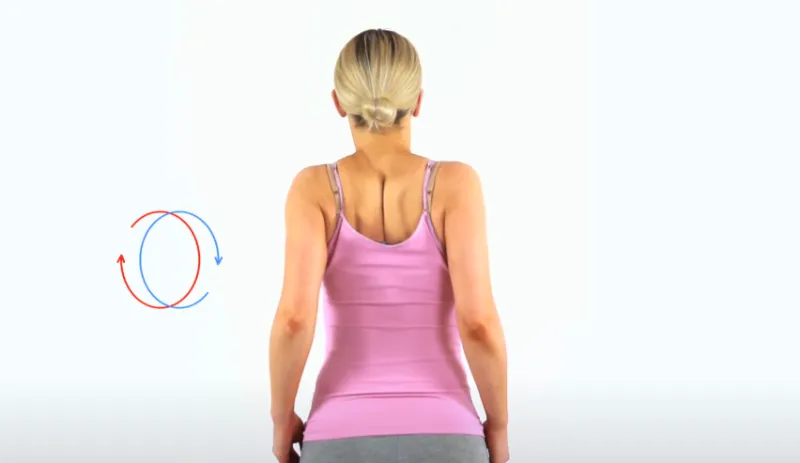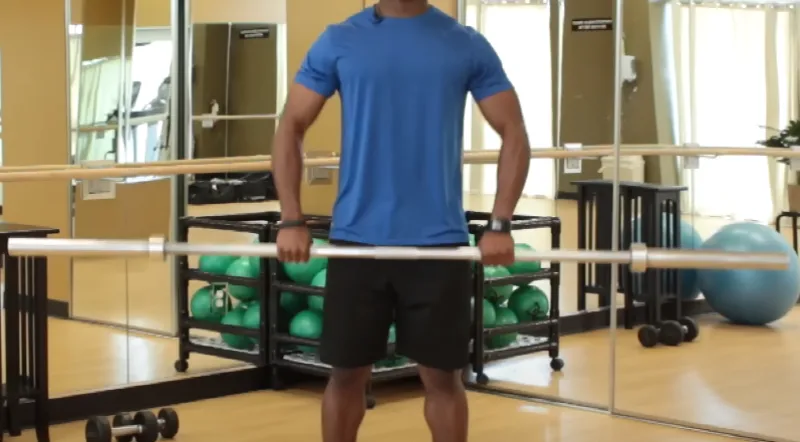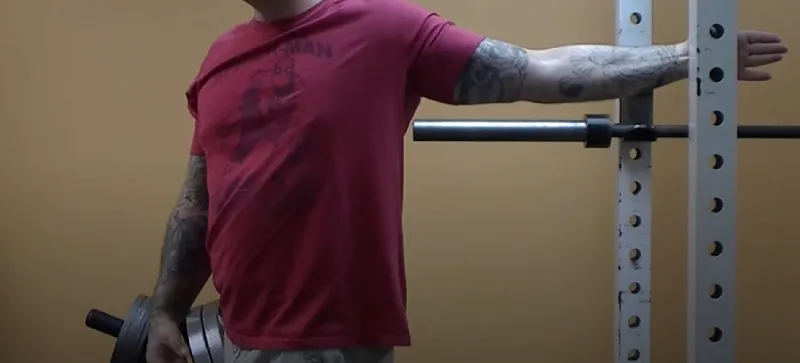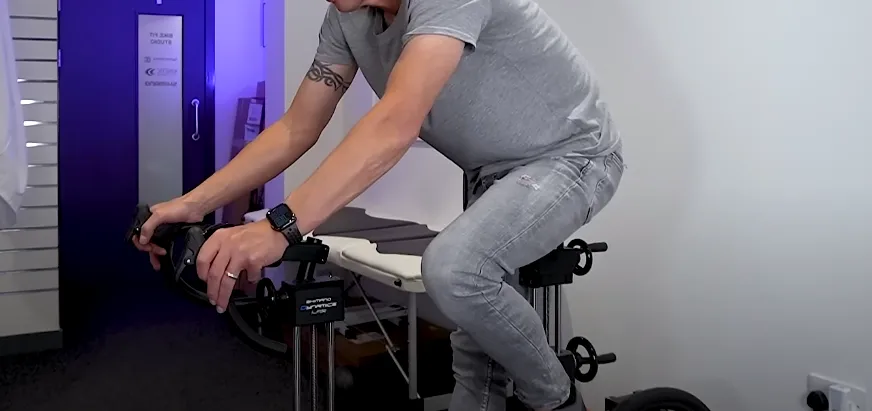A strong neck helps to prevent pain or injury during longer rides and ensures a proper posture while riding. It can increase your ability to spot potential hazards on the road.
You can stretch your neck by standing and bowing your head while applying downward pressure with your hand. The stretch should begin in your neck and extend down your back. Keep holding for about a minute.
This blog post explains the most effective exercises and stretches for strengthening and increasing the flexibility of your neck for a more comfortable and safer cycling experience.
Key Takeaways
- Isometric Exercises: Hold the head against resistance, which improves endurance and reduces injury risk.
- Neck Extension Prone: Lifting the head while prone enhances posture and reduces discomfort.
- Side-Flexor Strengthening: Tilt head side-to-side improves balance and reduces pain.
- Wall Lean: Lean your head against the wall to prevent fatigue-related failure.
- Neck Retraction with Band: Pull the head back against the band, strengthen muscles, and improve posture.
- Shoulder Rolls: Relieve tension and enhance posture.
- Head Turns: Increase neck mobility and reduce pain.
- Neck Flexes: Improve flexibility and relieve stiffness.
- Upright Row: Strengthen neck and improve upper body mobility.
- Shoulder Blade Wall Press: Stretch muscles to reduce upper back pain.
How Do I Strengthen My Neck For Cycling: 5 Workouts
By incorporating exercises to strengthen the neck muscles, cyclists can improve their performance and minimize the risk of injuries. We will explore the top exercises for neck strength that are specifically beneficial for cycling.
How to Strengthen Neck Muscles with Isometric Exercises?
Isometric neck strengthening involves holding specific positions that target the neck muscles without movement.
Steps:
- Tilt your head back and place your palms on your forehead.
- Push your palms forward gently while resisting the movement with your neck.
- Hold the position for a few seconds and then release.
- Repeat the exercise for 3-4 sets of 10-12 repetitions.
Benefits:
- Isometric neck strengthening can improve endurance and reduce fatigue during long rides.
- Improved neck strength can enhance cyclist’s ability to handle rough terrains and bumpy rides, reducing the risk of accidents.
- Reduced neck pain and discomfort during cycling, improving performance and enjoyment.
Neck Extension Prone
One of the most effective exercises for neck strength is the neck extension prone. This exercise targets the muscles at the back of the neck, often neglected in other workouts.
Steps:
- Lie down on your stomach with your head hanging off the edge of the bed or bench.
- Slowly lift your head towards the ceiling, keeping your eyes straight down.
- Release the position after a few seconds.
- For each set, do 10-12 repetitions.
Benefits:
- Stronger neck muscles can improve posture and overall body alignment, reducing the risk of injuries.
- Improved neck strength can enhance a cyclist’s ability to maintain a clear road view, reducing the risk of accidents.
- Reduced neck discomfort and pain during long rides, improving performance and enjoyment.
Neck Side-Flexor Strengthening
The neck side-flexor strengthening exercise targets the muscles on the side of the neck responsible for lateral movements.
Steps:
- Straighten up with your arms by your sides.
- Tip your head slowly one way, bringing your ear closer to your shoulder.
- Keep your position for a few seconds, then return to the starting position.
- Repeat the exercise for both sides 3 to 4 times.
Benefits:
- Strong side neck muscles can improve balance and stability while cycling, reducing the risk of falls.
- Improved range of motion in the neck can increase cyclist’s ability to look over their shoulder, reducing the risk of accidents.
- Reduced neck pain during rides, improving comfort and performance.
Wall Lean Neck Strengthening

The wall lean neck strengthening exercise targets the muscles in the front of the neck, which is essential for holding the head up.
Steps:
- Stand with your back against a wall, with your feet shoulder-width apart.
- Tuck your chin down and slowly lean your head back towards the wall.
- Return to the original position after a few seconds.
- Count 10-12 repetitions for 3-4 sets.
Benefits:
- Strong neck muscles at the front can improve cyclist’s ability to hold their head up during long rides, preventing Shermer’s Neck, where neck muscles fail from fatigue and cannot support the head.
- Improved posture and alignment can reduce the risk of injuries and improve performance.
- Performance and enjoyment improved with reduced neck pain.
Neck Retraction with Band
The neck retraction with a band targets the muscles behind the neck, which is essential for maintaining good posture.
Steps:
- Loop a band around a sturdy object, such as a pole or door handle.
- Place the other end of the band around the back of your head.
- Stand shoulder width apart and gently pull your head back against the band.
- Release after a few seconds.
- You should repeat the exercise 3-4 times.
- You can increase the band’s resistance as you improve at the exercise.
- Strengthens and stretches the muscles with this exercise.
Benefits:
- Strong neck muscles at the back can improve posture and alignment, reducing injury risk and improving performance.
- With an expanded neck range of motion, cyclists can see and react to their surroundings, reducing the risk of accidents.
- Neck pain is reduced during rides, improving performance.
Strengthen Neck for Cycling: 5 Stretches
Whether you’re a beginner or a seasoned rider, incorporating the best neck stretches into a cyclist’s routine can help you boost your performance and feel more comfortable on the bike. We’ll explore the top 5 neck stretches for flexibility and mobility that you can use to strengthen your neck for cycling.
Shoulder Rolls

Shoulder rolls are a great way to loosen up tension in your neck and shoulders, as well as for neck hump. Scapular retraction is beneficial for your neck and shoulders as well. Here’s how to perform this stretch:
Steps:
- Lie on your back with your arms at your sides.
- Inhale deeply and lift your shoulders towards your ears.
- Exhale and release your shoulders down and back.
- Repeat this movement 10-15 times.
Benefits:
- Relieve neck and shoulder tension.
- Improve shoulder joint mobility.
- Enhance posture.
Head Turns
The head can help you increase the range of motion and mobility of your neck. Performing this stretch is as follows:
- Stand or sit with your back straight and your feet flat.
- Slowly turn your head to look over your right shoulder.
- Hold a few seconds, then come back to the center.
- Repeat on the left side.
- 10 to 15 times, repeat this movement.
Benefits:
- Improve neck flexibility.
- Reduce neck pain.
- Strengthen neck muscles.
Neck Flexes
Neck flexes are simple stretches that increase the range of motion and reduce neck tension. Here’s how to do this stretch:
- Lie flat on your back and keep your feet balanced.
- Lower your chin towards your chest.
- Return to the center after a few seconds.
- Do this 15-20 times.
To do a neck flexibility test, sit and turn your head to each side, aligning your chin with your shoulder at about a 90-degree angle.
Benefits:
- Increase neck mobility.
- Improve posture.
- Relieve neck pain and stiffness.
Upright Row

Upright row is a strength training exercise that targets the shoulders and neck muscles. Here’s how you do it:
- Place shoulders-width apart your feet and your arms straight in front of your body.
- Grip a set of dumbbells or resistance bands.
- Raise the weights towards your chest, keeping your elbows close to your body.
- Lower the weights back down and repeat.
Benefits:
- Strengthen shoulder and neck muscles.
- Improve posture.
- Increase upper body mobility.
Shoulder Blade Wall Press
A shoulder blade wall press is another great stretch that can reduce neck tension and improve shoulder mobility. It can be done at the gym as well. Here’s how you do it:
- Place your back against a wall, shoulders broad, and about a foot away from the wall.
- Reach your arms up and place your elbows and hands against the wall.
- Walk your feet forward until your arms are fully extended.
- Push your shoulder blades down towards the ground.
- After a few seconds, release and repeat.
Benefits:
- Improve shoulder joint mobility.
- Stretch neck and shoulder muscles.
- Reduce neck and upper back pain.
Neck Exercises for Cyclists: Additional Workouts
Mobility is an often overlooked aspect of cycling. Neck strength improves performance. Here are some exercises and stretches from the additional exercises and stretches to improve posture and spinal health section that can help you strengthen your neck for cycling.
Back Extension
The back extension is an excellent exercise for improving posture and spinal health. Here’s how to properly execute it:
- Lie on your back and raise your arms above your head.
- Get your chest and arms off the ground.
- Hold for a few seconds while keeping your neck in a neutral position.
- Slowly lower back down to the starting position.
Cat Pose
The Cat Pose is a classic yoga posture that involves arching and flexing your spine. Here’s how to do it:
- Hands under shoulders and knees under hips, on your hands and knees.
- Take a deep breath and arch your back, moving your tailbone and head towards the ceiling. This is the cat position.
- As you exhale, move your pelvis back towards your heels and round your spine towards the floor. This is the cow position.
- Continue to alternate between the cat and cow positions for several breaths.
This exercise can help improve spinal flexibility and mobility, which are essential for proper posture and overall spinal health.
Chest and Bicep Stretch

The Chest and Bicep Stretch can help improve shoulder and chest mobility. Here’s how to do it:
- Stand facing a wall at shoulder width.
- Place your right hand on the wall at shoulder height.
- Keep your elbow straight and slowly lean forward, stretching your chest and bicep muscles.
- Repeat the stretch on the other side for 30 seconds.
Seated Thoracic Extension
The Seated Thoracic Extension targets the upper back muscles and can improve posture. Here’s how to do it:
- Sit on a chair with your feet flat on the ground and your hands behind your head.
- Keeping your elbows wide, squeeze your shoulder blades together and arch your upper back.
- Count to a few seconds, then relax.
- Repeat for several repetitions.
This exercise can help improve your upper back strength and flexibility, essential for maintaining good posture.
Open Book Stretch
The Open Book Stretch is an excellent stretch for improving thoracic spine mobility. Here’s how to do it:
- Lie on your side with your knees bent and arms extended before you.
- Keeping your knees together, rotate your upper body towards the floor and hold the stretch for a few seconds.
- Repeat on the other side.
Lumbar Extension Back Bends
The Lumbar Extension and Back Bend target your lower back muscles and improve your posture. Here’s how to do it:
- You should lie on your stomach, with your elbows close to your sides and your hands under your shoulders.
- Press into your hands and lift your head, chest, and shoulders off the ground.
- Hold for a second, then lower back down.
- Repeat for several repetitions.
Cable Machine Neck Exercise
Ready to level up? A cable machine can directly target your neck muscles, strengthening them for those long cycling adventures. Steps for Performing the Exercise:
- Attach a rope handle to the low setting of a cable machine.
- Kneel or sit with the side of your head facing the machine, the rope handle behind your ear.
- Push your head against the rope’s resistance, then slowly return to the start position.
- Repeat on both sides.
Weighted Helmet Neck Exercises
Simulating the weight of a helmet during training can significantly boost your endurance on real rides. The exercise is performed as follows:
- Wear a helmet with added weights or a specially designed weighted helmet.
- Perform regular neck exercises and stretches while wearing the weighted helmet.
Formula 1 Driver Neck Exercises
Formula 1 drivers need strong necks to handle high speeds. Their exercises can also benefit cyclists. Exercise steps:
- Use resistance bands attached to a fixed point and move your head against the band’s tension.
- Try static holds, keeping your head in a challenging position for as long as possible.
Conclusion
Incorporating neck-strengthening exercises, neck stretches, overall posture, and spinal health exercises and stretches can significantly improve your performance and comfort while cycling. Follow the steps outlined above, and you’ll be on your way to a safer and more enjoyable cycling experience.
By increasing your neck strength and flexibility, you can ride for more extended periods without discomfort and prevent injuries, ensuring the road ahead is smooth and enjoyable.
FAQs
How Do You Train Your Neck?
Stretch your neck by standing and bending your head downward. The stretch should spread down your back from your neck to your lower back. Keep it up for about a minute, then repeat.
What Are Some Simple Neck Exercises For Seniors?
Neck exercises for seniors can help improve neck mobility by allowing them to move their neck up and down, reduce pain, and prevent stiffness. They can also improve posture and reduce the strain on the neck muscles and joints. Some simple neck exercises for seniors are:
- Neck stretch: This exercise stretches the side of the neck and can be done sitting or standing. To do this exercise, tilt your head toward one shoulder as comfortably as possible, feeling the stretch on the opposite side of your neck. Hold for 15 to 30 seconds, then repeat on the other side. Do this two to four times on each side.
- Diagonal neck stretch: This exercise stretches the front and back of the neck and can be done sitting or standing. To do this exercise, turn your head slightly to one side, then tilt diagonally toward your chest as far as comfortable. Hold for 15 to 30 seconds, then repeat on the other side. Do this two to four times on each side.
- Neck rotation: This exercise improves the range of motion in the neck and can be done sitting or standing. To do this exercise, slowly turn your head to one side as far as possible, looking over your shoulder. Hold for 15 to 30 seconds, then repeat on the other side. Do this two to four times on each side.
- Neck side flexion stretch: This exercise stretches the side and back of the neck and can be done sitting or standing. To do this exercise, reach across your chest with one hand and hold your opposite shoulder down. Tilt your head to the same side as your reaching hand, bringing your ear toward your shoulder. Hold for 15 to 30 seconds, then repeat on the other side. Do this two to four times on each side.
Remember to do these exercises slowly and gently, and stop if you feel any pain or discomfort. You can also watch this youtube neck exercises video for more guidance on how to do these neck exercises for seniors.
How do I do somatic exercises for the neck?
Somatic exercises for the neck are simple and can be done anywhere. You can do them sitting or standing, as long as you are comfortable and relaxed. Here are some examples of somatic exercises for the neck:
- Neck roll: Slowly roll your head in a circular motion, starting from the right side, then to the back, then to the left, then to the front. Repeat this five times, reverse the direction, and do another five times. Allow the weight of your head to guide the movement and feel the stretch in your neck muscles.
- Neck tilt: Tilt your head to one side, bringing your ear toward your shoulder as far as comfortable. Hold for 15 to 30 seconds, then repeat on the other side. Do this two to four times on each side. Feel the stretch on the opposite side of your neck and relax your shoulders.
- Neck rotation: Slowly turn your head to one side as far as possible, looking over your shoulder. Hold for 15 to 30 seconds, then repeat on the other side. Do this two to four times on each side. Feel the rotation in your neck and the movement of your eyes.
- Neck extension/flexion: Slowly tilt your head back as far as comfortable, looking up at the ceiling. Hold for 15 to 30 seconds, then slowly tilt your head forward, bringing your chin toward your chest. Hold for 15 to 30 seconds. Do this two to four times. Feel the stretch in the front and back of your neck and the movement of your jaw.
What are some of the exercises and equipment that Josh Bryant recommends for neck training?
Josh Bryant recommends using a variety of exercises and equipment to train the neck from different angles and with different resistance levels. Some of the exercises and equipment that he recommends are:
- Neck harness: This device attaches to the head and loads the neck with weights or bands. It can perform neck extensions, flexions, rotations, and lateral flexions in different positions, such as standing, lying, or kneeling.
- Manual resistance: This method applies resistance to the neck with the hands or a partner. It can perform isometric or dynamic contractions of the neck muscles in any direction.
- Neck machine: This machine provides a fixed or adjustable resistance to neck movements. It can perform neck extensions, flexions, rotations, and lateral flexions with a controlled range of motion and intensity.
- Neck flexion: This device attaches to the forehead and allows for loading the neck flexion movement with weights or bands. It can perform neck flexions in different positions, such as standing, lying, or kneeling.
- Neck bridge: This exercise involves supporting the body weight with the head and feet and arching the back. It can strengthen the neck extensors, upper back, and spinal erectors.
Does Neck Hanging Exercise Work?
Yes, neck hanging exercises can reduce back and neck pain while improving overall posture. Additionally, it enhances shoulder, hip, and knee flexibility, making it an excellent exercise for balance and stability.
How Do You Treat Your Neck?
To treat your own neck, try moving more, applying hot or cold therapy, and taking OTC medications. Additionally, specific neck pain exercises and improving posture can help alleviate discomfort.
Can I Adjust My Own Neck?
No, cracking your own neck is not advisable. Doing so can push the joint out of alignment and may not effectively address swelling or scar tissue. It’s best to seek professional guidance for any neck adjustments.
Can You Do Neck Hump Exercises At Home?
Yes, you can do neck hump exercises at home. Try chin tucks, scapular squeezes, pec stretch with neck extension, thoracic mobility, and back strengthening exercises for a comprehensive routine. These exercises target specific muscles to help reduce the appearance of a neck hump.
How Do I Support My Neck While Exercising?
You should avoid extending your chin when looking down or upward while exercising to support your neck. Alternate shoulders when carrying weights, like a golf bag, to distribute strain evenly. Avoid overextending your neck in yoga poses or when looking behind you to prevent stressing the neck joints.
Can I Adjust My Neck At Home?
It’s advisable to approach neck adjustments cautiously, especially when considering self-adjustments at home. To avoid potential risks, consult a professional before attempting any adjustments. Implement gentle stretches and exercises, but prioritize safety and seek expert guidance for proper neck care.
Does A Bike Ride Build Glutes?
No, cycling primarily works your legs and glutes for endurance rather than building big muscles. While it helps tone these areas, cycling may not provide enough resistance for significant muscle growth. Incorporating strength training exercises may be more effective for specifically targeting glute development.
Can I Do Exercises to Correct My Cervical Curve?
Yes, specific exercises can help correct your cervical curve by strengthening and stretching neck muscles, improving posture, and returning the neck’s natural curvature. Try exercises like chin tucks, scapular squeezes, and cervical range of motion movements to enhance your neck health. Aim for daily practice to see improvements in your cervical curve.
How Can I Restore Cervical Curve With Exercises?
The first step to restoring your cervical curve is to place a towel around the base of your neck. Gently look up towards the ceiling, then lower your neck towards your chest without causing pain. Repeat this movement ten times slowly for effective results.
Why Does My Neck Hurt After Pilates?
Your neck may hurt after Pilates due to the strain caused by lifting your head during exercises like The Hundred or Single Leg Stretch. This strain is common, especially for beginners, as the neck muscles are not yet accustomed to the movements. To alleviate this discomfort, focus on maintaining proper form and engaging your core to reduce strain on your neck.
Can The Iron Neck Be Used to Strengthen The Neck of Cyclists?
Yes, the Iron Neck can effectively strengthen cyclists’ neck muscles. It offers isometric neck strengthening exercises to target specific muscles and improve endurance. Additionally, it enhances posture, reduces fatigue, and alleviates neck pain during cycling.
Can A Cyclist Use A Head Strap to Do Neck Exercises?
Yes, a cyclist can use a head strap to perform neck exercises. It can help support proper form and alignment during the exercises. Ensure the head strap is comfortable and does not restrict movement.
Can Heavy Helmets Cause Neck Pain for Cyclists?
Yes, heavy helmets can cause neck pain for cyclists by straining the cervical nerve roots. To minimize this, cyclists should choose helmets carefully, perform neck stretches, and do strengthening exercises. Selecting helmets based on a person’s build, posture, and muscular strength can help prevent neck pain.
How Do You Strengthen Neck Muscles for Posture?
To strengthen neck muscles for better posture, incorporate chin tucks, prone cobras, and downward neck tilts into your routine. Adjust your sitting posture by elevating your desk to eye level and using a chair that supports good posture. Include exercises like back burns and side head tilts to target various neck muscles for effective strengthening.
Do Headstands Strengthen Your Neck?
Yes, headstands can help strengthen the neck by building stability and strength. Additionally, going upside down in a headstand position can enhance proprioception, improving awareness of body position in space.
Does Neck Strength Prevent Concussions?
According to a Journal of Primary Prevention study, neck strength correlates with concussion likelihood. The research suggests that for every one-pound increase in neck strength, the odds of experiencing a concussion decrease by 5%. Therefore, improving neck strength may help in preventing concussions.


